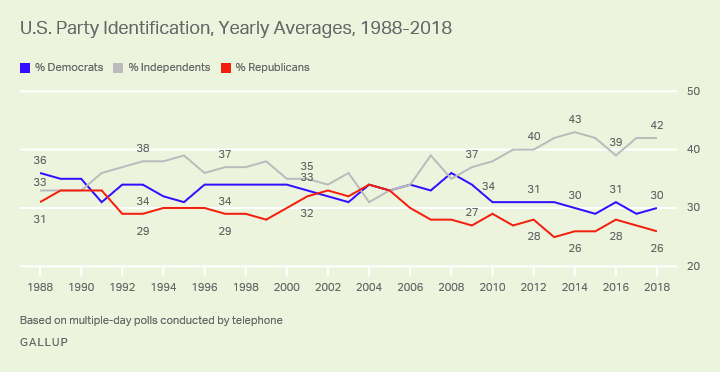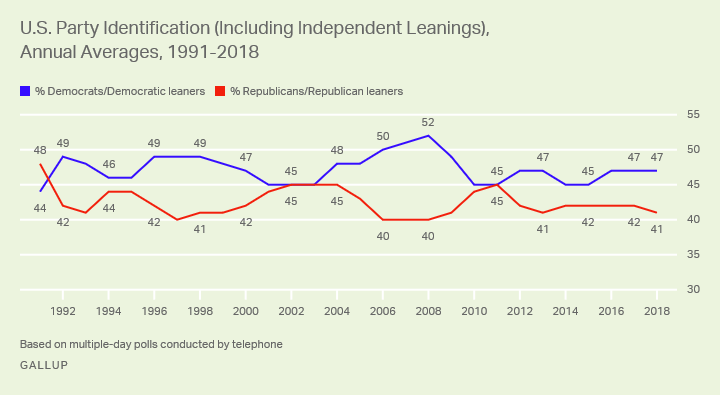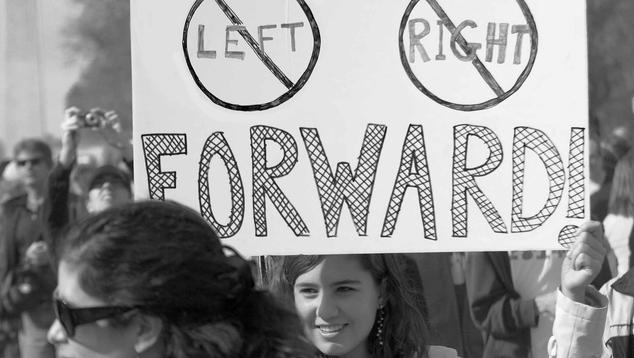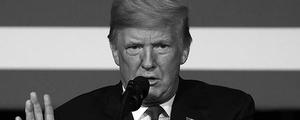Story Highlights
- 42% identify politically as independents
- 30% identify as Democrats, 26% as Republicans
- Democrats hold six-point edge when party leaners are included
WASHINGTON, D.C. -- Significantly more U.S. adults continued to identify as political independents (42%) in 2018 than as either Democrats (30%) or Republicans (26%). At least four in 10 Americans have been political independents in seven of the past eight years, including a record-high 43% in 2014.

The trend is based on aggregated data from all Gallup polls conducted in each year. The 2018 aggregate includes 13 separate surveys, encompassing interviews with more than 13,000 U.S. adults. Gallup asks Americans in every poll it conducts whether they identify politically as a Democrat, a Republican or an independent.
Over the past 30 years, when Gallup has regularly conducted its surveys by telephone, independents have typically outnumbered Republicans and Democrats. However, in just the past decade, an increasing proportion of adults have identified as independents, reaching 40% for the first time in 2011 and generally maintaining or exceeding that level since then. As a result, since 2011, the percentage of independents has exceeded the percentage identifying with the Democratic Party by 11 points on average, and the percentage identifying as Republicans by 14 points.
The one recent year in which independent identification fell below 40% was 2016, when 39% of Americans did so. The dip that year is consistent with the historical pattern by which fewer Americans identify as independents in presidential election years, when a flood of publicity for the two major parties tends to activate partisan leanings. Since 1992, the percentage of independents has dropped three percentage points on average in presidential election years.
The recent rise in independent identification has come at the expense of both parties about equally. Compared with 30 years ago, when 33% of Americans identified as independents, the percentage of Republicans has fallen five points and the percentage of Democrats has fallen six points.
The proportion identifying with each party is near its low in the telephone-polling era. The 26% identifying as Republicans is one point above the low from 2013, and the 30% identifying as Democrats is one point above its 2015 and 2017 lows.
Gallup has asked the same party identification question it does today in polls as far back as 1951. Gallup interviewing in the 1950s through the mid-1980s mostly used a face-to-face mode rather than the telephone. Experiments at the time suggested the results obtained by phone versus in-person interviewing differed slightly. Even acknowledging those methodological differences, it is safe to conclude that the percentage of independents today is higher than in any year since at least 1951, given that many fewer identified as independents in the 1950s, 1960s, 1970s and 1980s than do so today. Accordingly, the percentage of Democratic identifiers is near its historical lows, because the percentage of Democrats in the 1950s through 1980s was much higher than in any recent year.
Gallup did measure lower proportions of Republican identifiers after Watergate in the mid- to late 1970s, with percentages in the low 20s, so the current levels of Republican identification are probably not among the lowest Gallup has ever measured.
Democratic Edge Over GOP Expands After Party Leanings Are Taken Into Account
Since 1991, Gallup has consistently asked independents whether they lean toward either of the two major political parties. Most independents do express a party leaning when probed, and when those leanings are taken into account, 47% of Americans on average in 2018 were Democratic identifiers or Democratic-leaning independents, and 41% were Republicans or Republican-leaning independents.
The Democrats' six-point edge on this measure of party affiliation is in line with their five-point advantages in both 2016 and 2017.

Democrats have led on this combined party ID measure in most years since 1991, with Republicans outnumbering Democrats only in that first year, when George H.W. Bush had especially high job approval ratings after the Gulf War.
The Democratic lead has been as large as 12 points. This occurred in 2008, the year Barack Obama was elected president to replace George W. Bush, who had approval ratings in the high 20s or low 30s. By 2010, Republicans had essentially drawn even with Democrats after the passage of the Obamacare health legislation, but the Democrats have regained and maintained a consistent edge since then.
Implications
One of the major political developments in recent years is the increasingly polarized views of Democrats and Republicans, both in ratings of the president and on issue positions. A probable contributing factor to this is the shrinking of each party's base, with a greater number of Americans identifying as political independents. Those who maintain their Democratic or Republican identification are likely the U.S. adults who are most committed to the party and what it stands for, and thus most inclined to hold attitudes consistent with the party's platforms and talking points.
The contraction of the party bases has occurred about equally among both parties and has allowed the Democratic Party to maintain its usual advantage over the Republican Party in terms of its share of the adult population. As such, Republicans' ability to remain competitive in national elections continues to depend on having higher turnout among its supporters, something it was able to do in the 2010 and 2014 midterm election years but not in 2018.
Learn more about how the Gallup Poll Social Series works.




